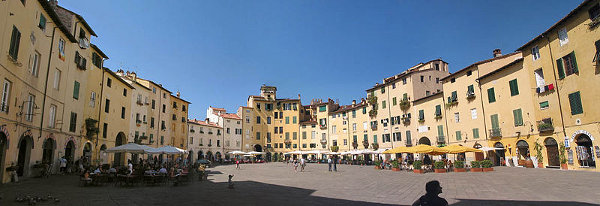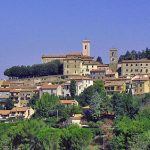Lucca is definitely one of the jewels of Tuscany, mindful of the great moments of splendor, arts, crafts, economy and culture. E ‘”the encircling the city” as he celebrated the unforgettable Gabriele D’Annunzio. The first traces of man found in the area lead back to the Ligurian people but with the Etruscans, like the rest of Tuscany and the Maremma low, you see a population increase combined with the economic and artistic growth, through trade and trade. The Etruscans and the Romans after they left valuable evidence, the remains of which are present all over the territory.
With the Romans in 89 BC, became the town hall and was perhaps the most intense period of turmoil that lasted about two centuries.
After the Romans it was the turn of the invaders took turns on the conquest of the Italian territory, and obviously suffered the same fate in Lucca, road junction of major roads. First came the Goths, then the Byzantines, the Lombards and later became a duchy and with whom strategic shift, and partly forced, down toward the valley of the Tiber to move to the other Lombard kingdom, Puglia.
Lucca became important in Tuscany thanks to the leader Castruccio Castracani to Paul Guinigi who started the artistic and cultural development. But the reputation of Lucca went beyond the Italian borders spreading its fame thanks to the intense and rich silk trade with l ‘Europe and Asia.
In 1799, the city was conquered by the French and by Napoleon, became a principality of Happy Baiocchi and Elisa Bonaparte, sister of the Emperor, until 1814. After the fall nopoleonica, the Austrians held the state until the Congress of Vienna that gave the Duchy of Lucca, in Maria Luisa of Bourbon and his son Charles Louis.
In 1847, Carlo Ludovico gave the Duchy of Tuscany Leopoldo 11, but already in the air were those liberal ideas that would lead a few years later, to join him to Italy.
The University of minters is very old and was already present allíepoca of Lombard rule. Many documents kept in the archives of the Archbishop, documenting their activities. The “Moneturius” (minter) formed a corporation and under the protection of St. Eligio was called Collegium Monetariorum “which was headed by a” Monetae Magister (Master of Coin). All those who belonged to this University were called “Overieri” (those who make money) and admission was not easy because it involved the knowledge of art, as evidenced by their freshman and was made to swear on the Holy Gospels commitment to exercise rectitude the profession granted to Lucca by various emperors. In the premises of the Inquisition of the Mint of Lucca, the “College of minters” is active again with the ancient methods of refining, merge, cut through metal (secrets jealously guarded by a few families of Lucca, called “De lineage Monetae”).
Our production is aimed at the reconstruction of the ancient coin reconstruction is done by studying more specimens of the same in weight, size and style so to get a design and a well detailed model, from which they are made punches males, engraved and worked burin. The old Inquisition of the Mint has made in Lucca, at its premises in Via S. Andrea 45 (near the tower Guinigi), an exhibition that traces the history of money over the centuries and can be visited on weekdays and holidays from 9.30 to 13 and 14.30 to 19 dolle except Monday morning.
Visit the villas of Lucca company is of no small importance if you plan to exhaust the discussion of this theme with an excursion for a specified time, you run the risk of usual underwent a ‘smattering of news accompanied by a sequence of images that – while picturesque and charming – never going to give us back the full complex of cultural and environmental values of that civilization in the villas of Lucca realizes that – together with the walled city – its highest expressive moment.
More than three hundred large and small are in fact the residences in the Lucchese villa is built over more than four centuries on the most beautiful places in the countryside and the arc of hills surrounding the plain of Lucca, from the early fourteenth century settlements were born as lodges hunting, through the great sixteenth-century villas of the affluent middle-class families engaged in art and in the silk trade, which drew the land and the environment as a superb natural setting, to the numerous imitators that the revival of those models completed the landscape – in later periods and up to the beginning of the twentieth century – with an interminable series of gentle and civilized traits, such as those offered to the visitor even more hasty. This heritage is still all in private hands, which he often passed from one generation to ‘other with tender care that the Lucchese manifest in the things that they know are desdnate to stay, and through it is developing a new way to propose to ‘external appreciation through the rebirth of hospitality, typical production, hospitality culture and the liberal arts. The visitor is thus faced with a limited repertoire of monuments, but a permanent witness of values that includes architecture, landscape, agriculture, traditional activities, food and wine, and even recesses of quiet and meditation, contemplation and spiritual regeneration, enjoyment of the environment in corrupt, in which it is necessary to penetrate with progressive enthusiasm, without the feverish restlessness of tourist to time, seeking as the measure for each one proves to be more convenient. In other words, on tiptoe.
Says Borchardt, he clearly recognized the Lucca and long stays there: “The villa honors already far away to visitors, ripagandolo of all that denies him until he èsemplice tourist”. Anyway, this trip must be organized in one or more paths, none of which – say it now – will be limited to the theme of the villas of Lucca, perhaps because the temptation would be to wander around aimlessly, following a wall of stones picked clean by the wind and surprisingly elegant meeting tables of ancient palaces hidden among the branches of trees, or enchanted by strong scents of the wine bubbling in the cellar and wait for the hills resolve the rosy sunsets. It is a journey that has few stages safe and is often entrusted to the initiative of the ancient character of the stranger, the once neglected mails to stop and investigate signs of civilization, choosing them in the vast panorama as in the apparently insignificant details and what drawing from the rest for the spirit that – at the end of the pilgrimage – gave him the certainty more returning better than when he left.
National Museum of Palazzo Mansi
It was purchased in 1965 by the Italian State as the venue for hosting the paintings of the national museums of Lucca.
National Museum of Palazzo Mansi
Via Galli Tassi, 43 – 0583/55570 – Fax 0583 / 31.22.21 – Opening 9/19 festive * 9/14 * closed on Mondays.
Cathedral Museum
E ‘consists of a thirteenth century tower house, a sixteenth-century church and a main body of the fourteenth century. On display are works of art that have characterized the centuries attachment and devotion to the emblematic figure of the Holy Face – ancient crucifix venerated in the Middle Ages throughout Europe.
In the sacristy of the Cathedral is visible what until now was considered that the tomb of Jacopo della Quercia carved llaria the Wheelbarrow – wife of Paul Guinigi who was the lord of Lucca between 1400 and 1430.
Cathedral Museum – Via Archbishopric – 0583 49.05.30 – Open daily April / Oct 10/18 – Nov / Tue 10/14 – Holidays 10/17
Lucca still retains its entire mighty walls, created primarily to strike military and administrative organization, because no one ever tried to capture it. The walls can be covered as a walk under a century-old trees that were planted allíepoca to cover the view of the towers in case of attack, but also as a supply of firewood.
In the following centuries the circle of ramparts was transformed into a sort of hanging garden suspended over the city. For centuries, the people of Lucca there had illegally planted small gardens, I had sent to graze their horses, while the ditches were used as external wheat fields or pastures for their herds.
The walk up the wall preferably on foot or in a carriage divenutaa in the eighteenth century was a must when you received principles strangers and an event not to be missed in the monotonous days of the nobility during the summer.
Even today, the ancient walls of the Lucchese have managed to preserve, protect the city center from the chaos outside, enveloping charm of one of the most beautiful cities díItalia and visitors should not miss líebrezza you feel in a relaxing and scenic stroll traveled for centuries of history.
The Villas of Lucca
The beautiful villas that can be seen in the most evocative of the countryside of Lucca, were built in the course of more than four centuries. There are over three hundred, including some fourteenth-century born as hunting lodges, like other great sixteenth-century villas of middle-class families and wealthy merchants of silk.
This heritage is still all in private hands,
meticulously passed down from one generation to another and strictly as. Only some of these villas can be visited today and can offer a welcome worthy of the best traditions of Lucca.
The structural matrix and formal Lucca is the presence of the villas, including this sense the whole of the villa itself: the whole property consists of real estate from the main building, the park, the farm, the farm houses, from the agrarian , by the woods and waterways. “The villa is harmonic distinction of vineyards and olive groves, cultivated fields and wild areas, houses of peasants and abode of the Lord” (Isa Belli Barsali) is the work of an urban middle class that invested the fruit of their earnings in land. A set built as a work of art, from a people refined. But this landscape, so popular today, it is not only the result of an operation of investment land. In the structural organization of this territory everything was kept in mind: the position of the land, water regulation, the order of the crops, the placement of buildings, the layout of the trees with great simplicity, modesty, functionality, order, poise, rigor. A common matrix for the organization and its definition is given by the accommodation in terraces or knolls of the land. With this technique, transformed the grounds of steep hill in flat parts, preventing soil erosion and harnessing the waters, regimate, you convogliarono where the man wanted to. It is the grand design of the Tuscan hills, is “adorned the amphitheater of hills” Borchardt, a series of signs, parallel to each other, curvilinear, that shape variously, but with continuity, the local context of the villa, constitute the bottom. It ‘s the result of the struggle, or the dialogue between man and nature to force, or to convince her to productive use, in accordance with its structure. It is the result of a secular work of which there are, in Lucca, certain documents by the end of the thirteenth century. This distinctive landscape Lucca is no exception to that Montaigne in the Journal de Voyage, in 1580, wrote: “On ne peut trop loeur the utilité et la beauté de la méthode de cultiver qu’ils ont les Montagnes jusqu’à the peaks, en faisant y, en forme d’escalier … “. In the relationship between settlement hills and crops, including villa, garden and landscape materials used also play a fundamental role: they are cooked on-site materials, such as brick kilns of the local (now all abandoned or demolished), limes prepared with limestone ceroid of Santa Maria del Giudice, sands and pebbles of the Serchio, the stones. It is precisely the stone materials to act as constitutive elements such as rags construction or as a cutting material, are used in the enclosure walls, the gates in the architecture, in pavements, in creases in the decorative bands, in the frames of doors and windows, in houses and oratories. The quarries of Matraia and Guamo were those that were addressed, one to the north, the other south almost to serve impartially two shares significant settlement of the villas. Yet the stones were also used together in dialogue with the brick, with their diversity of color. Sites rich in springs or served by a stream, with straightforward as possible derivations, were the ones most sought for the construction of the villas. The water in the villa, not only performs tasks related to the purely functional home life and agricultural work, became the occasion for the creation of works of embellishment and fun, of pure pleasure. The architecture of the water together with the architecture of the green form the micro-landscape inside the closed area of the villa; reach the highest levels of quality and hydraulic technique found in the many water lilies, ponds and fish ponds, with games secrets of water, varied architectural solutions, enhanced by statues and decorations made of rustic mosaics, stones of various colors, shells, with grotesque and monstrous. What nymphaeums are important and also studied the play of light that penetrate inside of these architectures in which the light beams form rainbows with the dust of water. But the game, the pleasure reunite properly, in a sort of civic sense and respect, which is typical of the soul of Lucca, to his neighbor: the water is not dispersed, is not altered, can shut down the available to the other.
http://tuscanysea.com/backoffice/immagini/tuscanysea.com/-17-5-2013-11-28-281.jpg
http://tuscanysea.com/backoffice/immagini/tuscanysea.com/-17-5-2013-11-28-282.jpg



